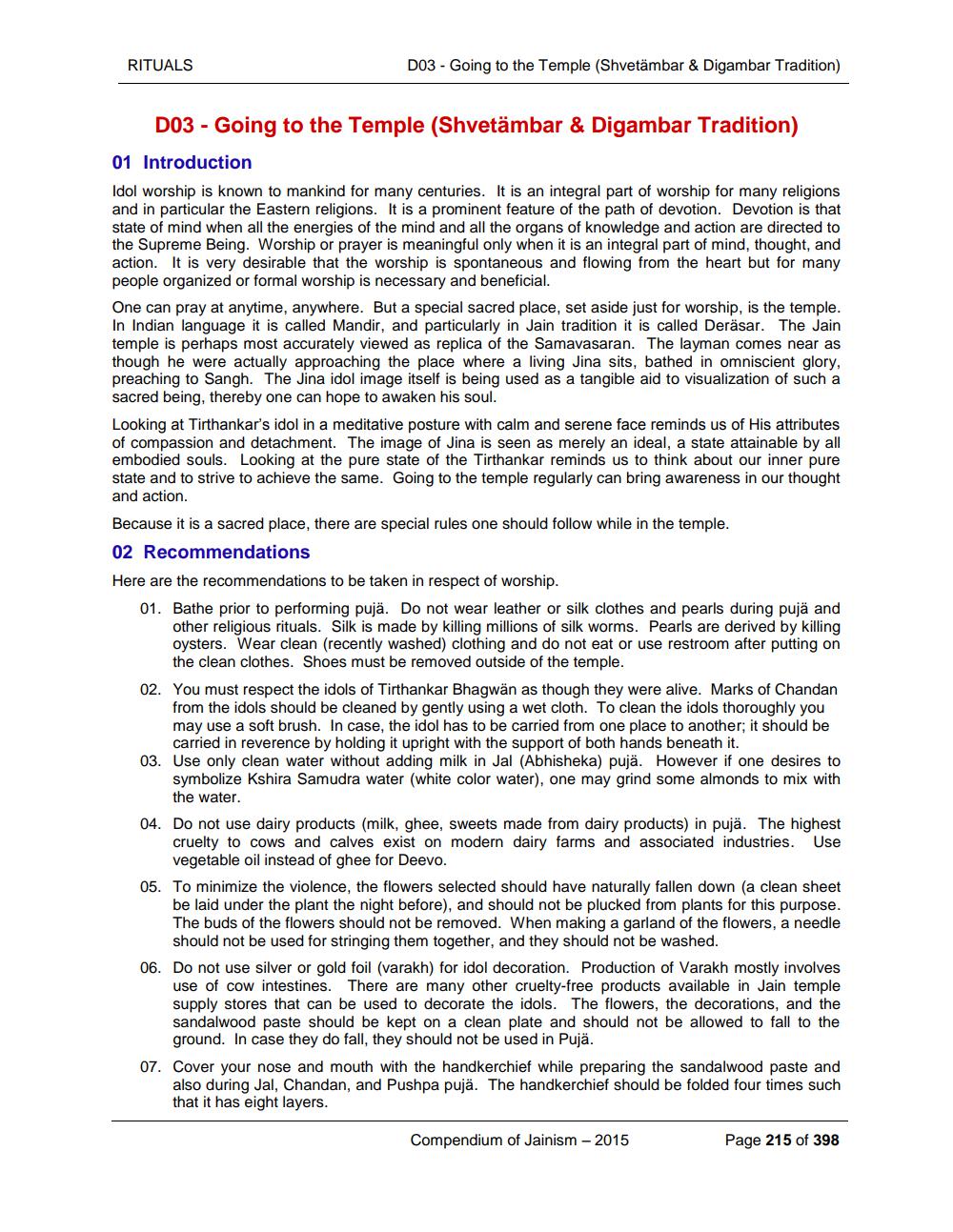________________
RITUALS
DO3 - Going to the Temple (Shvetämbar & Digambar Tradition)
DO3 - Going to the Temple (Shvetämbar & Digambar Tradition)
01 Introduction Idol worship is known to mankind for many centuries. It is an integral part of worship for many religions and in particular the Eastern religions. It is a prominent feature of the path of devotion. Devotion is that state of mind when all the energies of the mind and all the organs of knowledge and action are directed to the Supreme Being. Worship or prayer is meaningful only when it is an integral part of mind, thought, and action. It is very desirable that the worship is spontaneous and flowing from the heart but for many people organized or formal worship is necessary and beneficial. One can pray at anytime, anywhere. But a special sacred place, set aside just for worship, is the temple. In Indian language it is called Mandir, and particularly in Jain tradition it is called Deräsar. The Jain temple is perhaps most accurately viewed as replica of the Samavasaran. The layman comes near as though he were actually approaching the place where a living Jina sits, bathed in omniscient glory, preaching to Sangh. The Jina idol image itself is being used as a tangible aid to visualization of such a sacred being, thereby one can hope to awaken his soul. Looking at Tirthankar's idol in a meditative posture with calm and serene face reminds us of His attributes of compassion and detachment. The image of Jina is seen as merely an ideal, a state attainable by all embodied souls. Looking at the pure state of the Tirthankar reminds us to think about our inner pure state and to strive to achieve the same. Going to the temple regularly can bring awareness in our thought and action. Because it is a sacred place, there are special rules one should follow while in the temple. 02 Recommendations Here are the recommendations to be taken in respect of worship. 01. Bathe prior to performing pujä. Do not wear leather or silk clothes and pearls during puja and
other religious rituals. Silk is made by killing millions of silk worms. Pearls are derived by killing oysters. Wear clean (recently washed) clothing and do not eat or use restroom after putting on
the clean clothes. Shoes must be removed outside of the temple. 02. You must respect the idols of Tirthankar Bhagwan as though they were alive. Marks of Chandan
from the idols should be cleaned by gently using a wet cloth. To clean the idols thoroughly you may use a soft brush. In case, the idol has to be carried from one place to another; it should be
carried in reverence by holding it upright with the support of both hands beneath it. 03. Use only clean water without adding milk in Jal (Abhisheka) pujä. However if one desires to
symbolize Kshira Samudra water (white color water), one may grind some almonds to mix with
the water. 04. Do not use dairy products (milk, ghee, sweets made from dairy products) in puja. The highest
cruelty to cows and calves exist on modern dairy farms and associated industries. Use
vegetable oil instead of ghee for Deevo. 05. To minimize the violence, the flowers selected should have naturally fallen down (a clean sheet
be laid under the plant the night before), and should not be plucked from plants for this purpose. The buds of the flowers should not be removed. When making a garland of the flowers, a needle
should not be used for stringing them together, and they should not be washed. 06. Do not use silver or gold foil (varakh) for idol decoration. Production of Varakh mostly involves
use of cow intestines. There are many other cruelty-free products available in Jain temple supply stores that can be used to decorate the idols. The flowers, the decorations, and the sandalwood paste should be kept on a clean plate and should not be allowed to fall to the
ground. In case they do fall, they should not be used in Pujä. 07. Cover your nose and mouth with the handkerchief while preparing the sandalwood paste and
also during Jal, Chandan, and Pushpa pujä. The handkerchief should be folded four times such that it has eight layers.
Compendium of Jainism - 2015
Page 215 of 398




